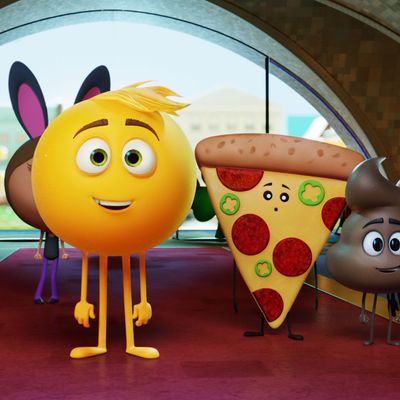
Looking back, I’m going to go out on a limb and say that there was a small, flickering reason to believe that The Emoji Movie wouldn’t be a complete travesty. After all, the adorably ubiquitous pictograms that have become a second language for at least two generations are a public-domain entity; their relative recent rise makes us forget that, licensing-wise, this is no bigger a grab than Leaves: The Movie would be. It was pretty much free to do whatever it wanted within the ridiculous, cynical parameters it had set. The Emoji Movie had nothing to sell aside from itself.
But this was naïve of me, because The Emoji Movie is selling something. In the mock tradition of countless superior Pixar films before it, it’s attempting to sell a sense of childlike wonder and fascination with an ordinary, everyday object: your smartphone. And in doing so, it is one of the darkest, most dismaying films I have ever seen, much less one ostensibly made for children.
Let me get briefly more philosophical than this film deserves: Emoji remain a ripe source for humor in our everyday digital parlance, specifically because they are devoid of narrative, or even, ironically, emotion. There is a kind of poetry that has emerged from their use; an emoji is worth maybe not a thousand, but certainly a hundred words, and using one in place of words requires you to momentarily, subconsciously imagine that you are living in a language-free totalitarian state where a cry-laugh symbol is our linguistic Soylent. There’s a similar pathetic humor to the constricted movement and expression of Lego figurines, which The Lego Movie exploited to far greater effect. The Emoji Movie’s first aesthetic mistake is redesigning their titular figures to be the same kind of rubber-faced caricatures you can find in any other shrieking CGI kid-distracter on the market. Not once does this film rise above the level of humor of literally any real-world use of a simple upside-down-face emoji (whose meaning I tend to translate as “Wheeee, life is a horrible hall of mirrors and I am powerless to do anything but smile about it.”)
If only my review of this film could be an upside-down-face emoji. The laboriously literal plot concerns the “Meh” emoji (T.J. Miller, who certainly doesn’t sound like a man who’s banking his career on this film as his game changer), who is “defective” due to his ability to express a kaleidoscope of emotions beyond his regimented role. I think this is the basic principle behind the Divergent films; it could just as easily be about a commercial actor in an existential rut. To fix his defect, he teams up with the lowly high-five emoji (James Corden), who has been replaced by the newer, hipper fist-bump emoji in the hall of favorites (racial subtext abounds). Together they escape the messaging app they call home on a dream-logic mission to find a “hacker” (Anna Faris) who can take them to the “cloud” and fix Meh’s defect. Along the way, they pass through a series of familiar apps while a battalion of anti-virus bots follows them in lukewarm pursuit. At one point, the film grinds to a halt for a game of Candy Crush.
Yes, the actual IP of The Emoji Movie has nothing to do with the emoji themselves, and everything to do with the apps that have prime placement in the Google AdWords–grade narrative. Somewhat relevant to the plot is the fact that it all takes place on the phone of a 14-year-old boy, who is having text-based girl troubles somehow worsened by Meh’s poor performance as an emoji. Apparently this 14-year-old boy not only has the usual suspects on his phone (Facebook, Instagram, and Spotify all make appearances), but also, mystifyingly, the Crackle app, and extra-mystifyingly, a Just Dance mobile app that I wasn’t even aware existed before now and currently has a two-star rating on the Apple store.
There is a mumbled, shorthand moral about staying true to yourself in all this, but it is drowned out by the wall-to-wall cynicism that is The Emoji Movie’s entire reason for existing in the first place. The film runs through its list of corporate and Zeitgeist awareness obligations in dead-eyed lockstep, making sure to get in uses of the words “slay” and “shade” and lifting an entire section of the lyrics to Rihanna’s “Diamonds” to telegraph a would-be important emotional beat (it’s not a joke, I don’t think). In the end, Meh’s embrace of his animated, multifaceted self just comes off as an ad for an Emoji Movie animated-sticker set that’s probably already out there.
This is a film that seems beamed from a near future in which nothing goes right; “words,” as the kids in the film agree, “aren’t cool” anymore; and Patrick Stewart making jokes about soft shits is the new prestige TV. But what do I know? At my screening, which was for both press and a handful of unfortunate families, at the first sighting of her favorite rainbow-colored icon, a little girl behind me cried out, adoringly, “It’s Instagram!” A new age of heroes is born.

